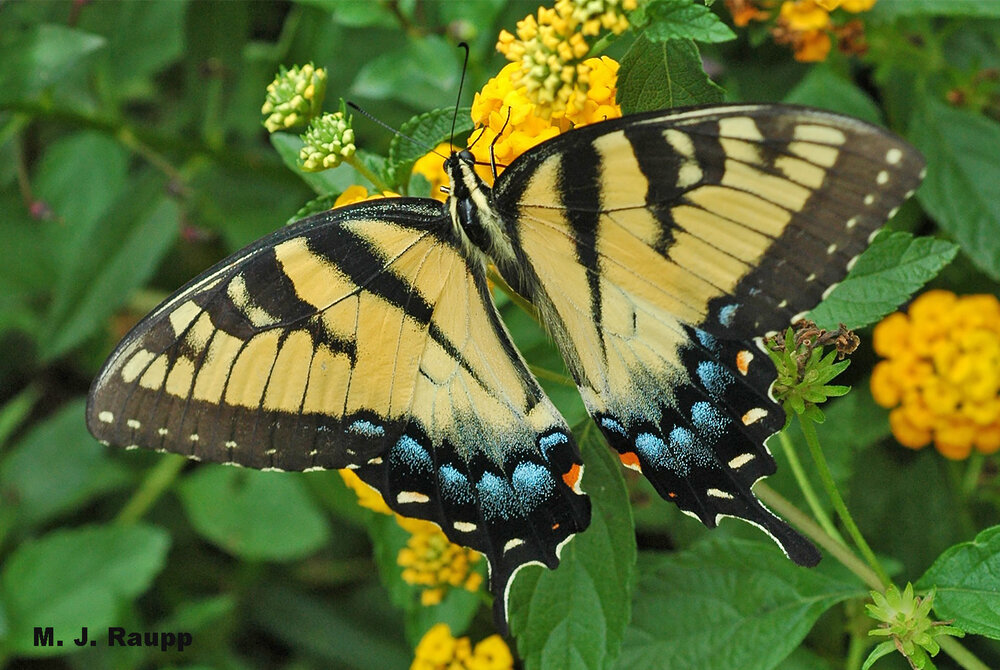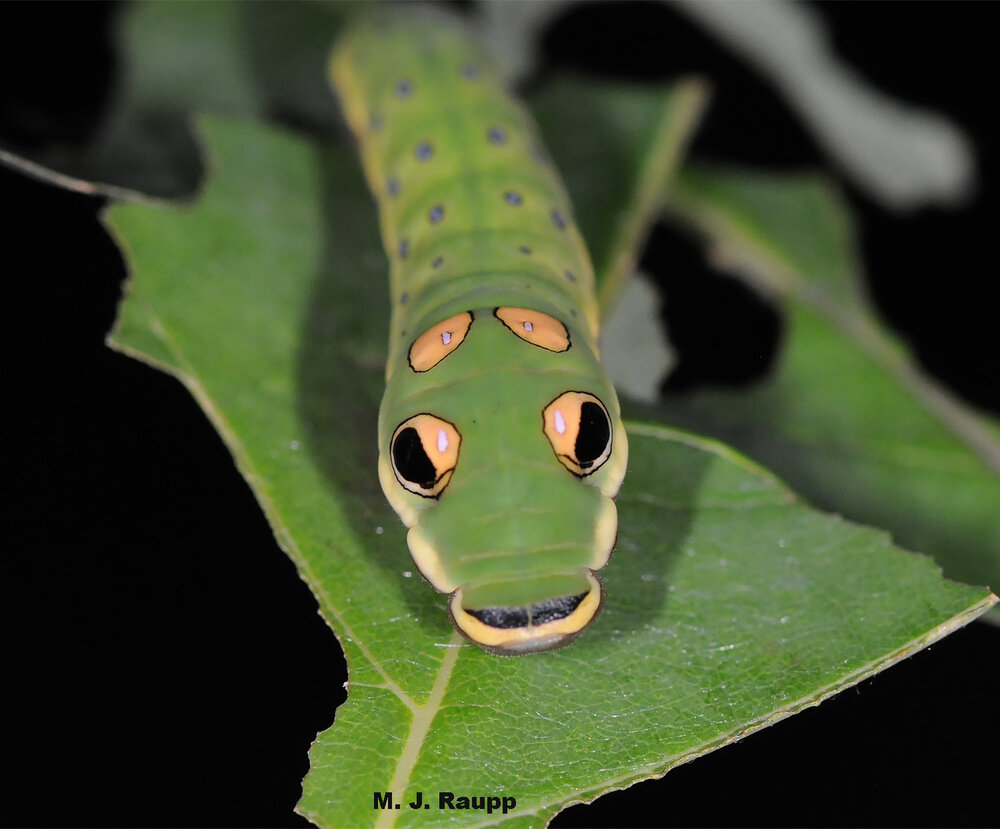Missing bugs of the week: Swallowtail butterflies, Papilionidae

Beautiful eastern tiger swallowtails have been relatively scarce in my garden thus far this year.
“Where are the butterflies?” Somewhat panicked questions like this started arriving several weeks ago and they don’t seem to want to go away. At first I was reluctant to acknowledge another concern in a year rife with uncertainty surrounding murder hornets, COVID19, and social unrest. Last week after a miserable showing of swallowtails at my butterfly magnet, also known as cup plant (Silphium perfoliatum), I shared the butterfly worries with several distinguished colleagues who confirmed that, yes, some butterflies were indeed scarcer this year in their gardens too. What a contrast to the summer of 2019, which seemed like butterfly nirvana with more than two dozen swallowtails nectaring at the same time on the cup plant in the front flower bed. This year, the butterfly magnet attained a paltry 3 swallowtails at any moment during the same week in which almost three dozen were sighted last year.

My dill and parsley escaped the jaws of very hungry black swallowtail caterpillars that usually grace my herb garden each summer.
So, what gives with the butterfly drought? We know that changes in land use patterns associated with urbanization are responsible for dramatic losses in several insect species, including butterflies, in cities around the world. However, declines in the abundance of butterflies from one year to the next are often linked to more immediate ecological events. There are several key drivers of insect abundance. One important determinant of insect abundance is weather. In previous episodes we met a pair of invaders from the south, harlequin bugs and kudzu bugs. We have learned that as winter temperatures dip into the low teens and single digits it is simply too cold for these rascals to survive in Maryland, and their populations persist only in warmer redoubts further south. A second vital factor for insect survival is, of course, food. Changes in insect populations related to food resources are generally termed bottom-up effects. Part of the explanation for declines in monarch populations in North America are linked to reductions in populations of milkweed plants critical for larval survival. Moreover, scarcity of high quality nectar sources necessary to sustain adults as they migrate to overwintering hideaways, survive winter’s chill, and sally forth in late winter and early spring to colonize breeding grounds may be reducing populations. A third major factor affecting insect populations, known as top-down effects, stems from Mother Nature’s hit squad of predators, parasites, and pathogens attacking, consuming, or infecting their victims. Long-term suppression of gypsy moths resulted when scientists reunited a fungal pathogen, Entomophaga maimaiga, from Asia with this killer of oak trees. This widespread pathogen helps keep gypsy moth at bay throughout much of its range.

No spice bush swallowtails or their amusing caterpillars have yet appeared in my landscape.
How does all this relate to missing butterflies? Most notably scarce are several of large swallowtail butterflies including eastern tigers, black swallowtails, and spice bush swallowtails we visited in previous episodes. Butterfly experts suggest that some of these large swallowtails may have been fooled by some exceptionally warm weather in February followed by a rainy, chilly, and in some places frosty March, April, and May. Freeze warnings, frost, and record cold temperatures were recorded in several locations in Maryland in early May. Perhaps a few late season frosts took a toll on these beauties. On the bottom-up side of things, some think that drought stress in late summer and early autumn of 2019 may have reduced the quality of food resources for caterpillars as they completed development, thereby reducing their numbers or perhaps reducing chances for survival of pupa about to face winter’s wrath. Some have suggested that a really good year last year for some caterpillars translated into higher numbers of parasitoids and predators. In previous episodes we met rapacious caterpillar killers like wheel bugs and spined soldier bugs. We also know that many vertebrate predators, including insectivorous birds such as chickadees, depend on caterpillars for their survival. When numbers of caterpillars increase, so too do the numbers of these birds. While swallowtails have been scarce this year, I have never enjoyed as many blue jays, cardinals, wrens, and chickadees zooming around the yard as I have this spring and summer. Perhaps a bounty of caterpillars in the spring of 2019 translated into greater numbers of predators and parasitoids that put a damper on populations of some of our butterflies this year.
Swallowtails and some other butterflies seem unusually scarce in the DMV this spring and early summer. Unusual weather including late spring frosts, poor quality food resources last autumn, and mortality related to predators and parasites may have conspired to reduce their numbers.
Should we fear that a scarcity of swallowtails in 2020 portends a pending butterfly apocalypse? Nah, I don’t think so. Many other species of butterflies appear to be doing just fine. Silver spotted skippers and their kin arrived in my garden right on schedule in great numbers, as did cabbage butterflies. Peregrinations along the C & O Canal this spring and summer revealed zebra butterflies in good numbers and doing just fine. However, scientists warn that in the long term issues such as urbanization and climate change, including bizarre and severe weather patterns, spell trouble for many species of plants and animals, including insects. But as I finish writing this episode and look out the window to the cup plant, I see four tiger swallowtails getting their carbohydrate fix. Maybe upcoming broods of swallowtails will be bigger and better than their predecessors.
Acknowledgements
Bug of the Week thanks science writer, butterfly guru, and keeper of the Lep Log Rick Borchelt for his insights and observations of butterflies throughout the region. Many thanks to colleagues in the Department of Entomology, especially Karin Burghardt and Leo Shapiro for providing references and helping clarify several points discussed in this episode. The following fascinating papers were consulted: “Western Monarch Population Plummets: Status, Probable Causes, and Recommended Conservation Actions” by Emma M. Pelton, Cheryl B. Schultz, Sarina J. Jepsen, Scott Hoffman Black and Elizabeth E. Crone; “Multiscale seasonal factors drive the size of winter monarch colonies” by Sarah P. Saunders, Leslie Ries, Naresh Neupane, M. Isabel Ramírez, Eligio García-Serrano, Eduardo Rendón-Salinas, and Elise F. Zipkina; “Declines and Resilience of Communities of Leaf Chewing Insects on Missouri Oaks Following Spring Frost and Summer Drought” by Robert J. Marquis, John T. Lill, Rebecca E. Forkner, Josiane Le Corff, John M. Landosky and James B. Whitfield; and “Nonnative plants reduce population growth of an insectivorous bird” by Desirée L. Narango, Douglas W. Tallamy, and Peter P. Marra.
This post appeared first on Bug of the Week